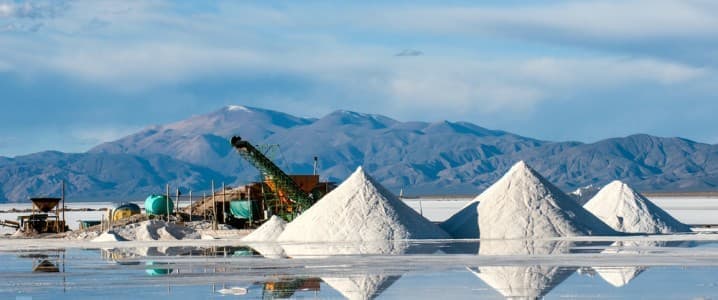The renewable revolution is causing a modern-day gold rush. Countries around the world are solidifying plans to implement mass-scale development of solar and wind farms and to electrify vehicle fleets. While this is great news for global greenhouse gas emissions, these renewable technologies still rely on the extraction of finite metals and minerals such as lithium, copper, and cobalt. So while the renewable revolution is associated with a downturn in fossil fuel extraction, it will fuel a major mining boom.
The International Energy Agency (IEA) projects that global renewable capacity additions will grow by a whopping 107 gigawatts (GW) to reach more than 440 GW in 2023, the largest absolute increase in history. Meanwhile, electric vehicle sales are expected to expand by 35% this year to reach 14 million, in an increase that the IEA has called “explosive growth.” The agency estimates that the growth of the EV sector will offset the need for 5 million barrels of oil a day by 2030.
All that growth is going to require an enormous boost in manufacturing capacity for components such as photovoltaic solar panels, wind turbines, and lithium-ion batteries for EV engines as well as renewable energy storage. That will require an enormous increase in the production of key rare Earth minerals. A report from Popular Mechanics published earlier this year contends that “an electrified economy in 2030 will likely need anywhere from 250,000 to 450,000 tonnes of lithium. In 2021, the world produced only 105—not 105,000—tonnes.”
Cornering the largely as-yet untapped rare Earth minerals market presents a major economic opportunity. Countries around the world are currently racing to build up their supply chains for primary materials such as lithium and cobalt. Companies and countries around the world are rushing to shore up supply chains and acquire reserves as quickly as possible. So far, the West is lagging far behind. China currently dominates rare Earth supply chains, and has continued to consolidate its already near-monopolistic market power as it increasingly pushes into emerging markets in Africa and Latin America. The United States is trying to establish similar trade agreements with lithium suppliers in Latin America, but has been met with some resistance.
Developing countries rich in rare Earth minerals stand to benefit far more from their extraction if they carry out value addition domestically instead of exporting primary materials to the U.S. or China. For this reason, Latin American producers have been working to establish regional renewable energy value chains instead of inking more deals with international interests. Now, India is following a similar trajectory. “Indian officials [...] want the country to expand its critical mineral mining operations and make its own clean energy infrastructure from start to finish,” ABC recently reported in an article headlined “India sets sights on home-mined minerals to boost its clean energy plans.”
While this strategy bodes extremely well for India’s own decarbonization trajectory as well as local economies, there are some concerns about the negative environmental externalities associated with a rapid rise in mining activity. “Any mining has impact,” Sandeep Pai of the think tank Swaniti Initiative was quoted by ABC. “India needs to be thinking of how everyone involved, including local communities, will benefit before they begin mining for critical minerals like lithium.”
The reality is that mining is a necessary trade-off for rapid decarbonization of the global energy mix. And if a developing market is going to be suffering the negative health and environmental consequences of a mining boom, they should be reaping the benefits too. This can be accomplished in part by building out whole supply chains domestically. The associated benefits would be related to the economic windfall of localized value addition, but also of cleaner air thanks to an increased uptake of EVs and renewable energies in their own markets.
Globally, we need to strike a balance that lies somewhere between too narrow of a focus on near-shoring and friend-shoring and too wide of a scope resulting in lopsided global supply chains. A happy medium would include a diversity of sources that doesn't give too much geopolitical power to any one entity (we’re looking at you, China) but which is interconnected enough to avoid shocks if any one market falters. The buildout of competing rare Earth minerals markets around the world is promising for such a balance. It not only means that the benefits of decarbonization will be shared more widely, it also means that the negative trade-offs will be more fairly dispersed as well.
By Haley Zaremba for Oilprice.com
More Top Reads From Oilprice.com:
- The Caspian Conundrum: Receding Waters Spell Trouble For Kazakhstan
- UK Energy Regulator Hits SSE Generation With Hefty Fine
- Is China's Economic Miracle Fading? A Look At The Hurdles Ahead


















